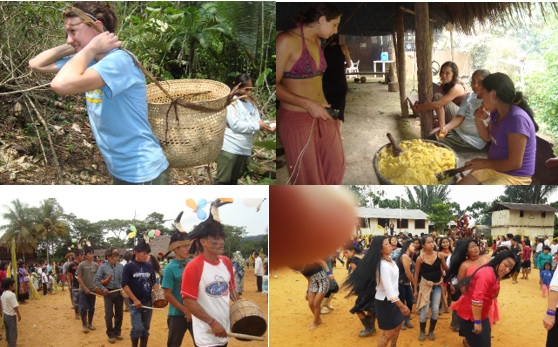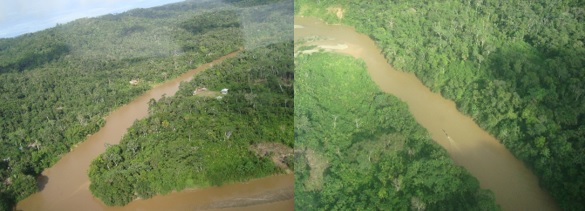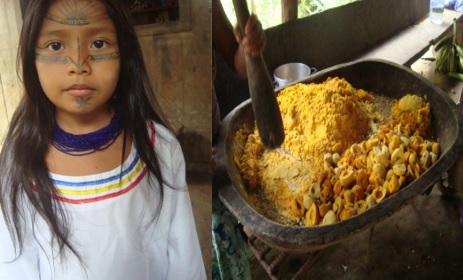SARAYAKU
COMMUNITY TOURISM
SERVICE WITH LODGING
Sarayaku, a Kichwa village in the province of Pastaza in the Ecuadorian East, is one of the most beautiful and richest Amazonian corners of the country, not only for its natural resources but for its culture. With just over 3000 inhabitants, it is the most populated community in block 23. This block covers 200,000 hectares of the Achuar, Shuar and Sarayacu towns, which is the largest. This town wants to replace the oil industry that wants to dominate the sector, to promote ecotourism.
DAY 1
Meeting, explanation of the trip and then breakfast departure to the community of Sarayaku, by plane or motor canoe as previously planned with the client and operator, if it is by plane it will be a flight of approximately 25 minutes depending on the weather and if it is In a canoe you have to take a private car for one hour and thirty minutes until you reach the Bobonaza river where the boat will be for transport and will last approximately 4 hours, maximum 10 Am.
Once in the community, we will look for accommodation in a lodging center. Double rooms with general bathrooms, for showers, the rivers will be used near the community.
Depending on the time, you will have food and a talk about the community of Sarayaku.
DAY 2
7 Am breakfast, then we will go to visit some indigenous houses to observe their traditions, return for lunch then rest, then practice some sports such as boating, handling of the bodoquera, pottery, we will see how the chicha is made and food preparation Typical with the help of tourists for dinner.
DAY 3
7 am. Breakfast and then we will take the motorboat to move one hour to visit Yana Rumi and Balsa Yacu where we will hike and swim in crystal clear small rivers in the company of birds and flora, we will have a cold lunch then we will visit some houses of companions indigenous Quichuas, arriving at the base camp for the special dinner with products from the area.
DAY 4
Breakfast and visit the center of the community and its surroundings to be able to greet with some leaders on duty and then lunch for the groups by plane and if it is a canoe breakfast and departure to Puyo 7 Am.
Tour by plane
Then we will move to the airport to return to Shell between 3 pm. it depends on the weather
Canoe tour
The departure will be at 8 am. Arriving in Puyo between 6 pm. depending on the level of the river.
End of our services
Note: we recommend to clients that we depend on the state of the weather to fly by plane, and the state of the river to make it faster. If you want more days, we can plan your tour.
CONTACTS – River Dolphin Expeditions
ANCESTRAL PARTY OF SARAYAKU IN THE PASTAZA CITY
The skins and feathers of all the hunted animals cover the Chayuc, the owner, and servant of the party. The men’s arrival. Fifteen days they hunted in the forest, they smoked the meat, they dried the leathers, they made their crowns.
The chicha for the Sarayaku inhabitants the main thing. The chicha calms the thirst and the hunger. Without drum, the party died. The drum calms anguishes and it challenges to nature.
They don’t cease. Since it dawns until it gets dark the drums of the town of the zenith they resound in the forest. Four days the drums of the men wake up children and visitors and they encourage the women that give the last touches to that yucca chicha that it doesn’t lack that it cannot lack. The drums are the only light in the dawns of the forest in the party. They illuminate the green roads, they congregate the residents and they dance in the wind.
Sarayaku, one of the most numerous and cohesive indigenous centers in the Amazonía, is in the party. In February the men and women Quichuas of Sarayaku celebrate to their town that – as their adults are proud – it is the nucleus of the indigenous towns of Pastaza, it is as the sun in the center, it is the town of the zenith. Them and them anxious
The party begins in the faces of the women of Sarayaku. One day before the arrival of their men they put on makeup with personalísimos and aesthetic designs. Their men will arrive of fifteen days of the uninterrupted hunt. Beautiful beaches of the biggest rivers traveled and of the smallest, they fished, they entered the thick forest, they hunted the most diverse birds and the slightest terrestrial animals.
While they are adorned, they also make it in a near beach in which you/they wait for the dawn of the first day of the party. Both picked up that plant it tints that it beautifies them, the witug, ferociously black. For more perspiration, for more river water, the Witug won’t leave while the party lasts. And the women and the men will remain then beautiful.
The arrival of the hunters: The women of Sarayaku arrive at the beach of the encounter, they have listed their chicha, the best homage for the out hunters. To be able to have it, they also worked fifteen days ago behind. They went to the mines of mud, they created the ceramic, they painted the mocahuas and the tinajas, they chewed until more not to be able to the yucca that them same they sowed and they prepared the
Chicha, in enormous quantities. Twenty, thirty, forty chicha tinajas rest in the houses. And now they wait anxiously in the river beach.
For behind of the fog, the first canoe appears. They come superb, of foot in perfect balance, with their knitted toucan crowns the previous day and with the chests covered with their hunt prowesses; skins and plumages of the animals hang as victory gear in each hunter. It commands them the Chayuc, responsible for the party for every year. One to one lowers, they receive the chicha and they incorporate to a circle of drums that rotates and it rotates and it rotates.
All are, they can already go to the house of the Chayuc to exhibit the product of the hunt. The hunt has been good; of the baskets they fall the monkeys, bagres, sajinos, squirrels, pavas, toucans, guantas, how many more. In a group what flies, in other what walks, in other that anything. More than 520 preys in total. In little time they already hang of the pillars, posts, and roof of the hunt of vegetable fiber and wood.
And again, the drums sing.
The day of the flowers
A Jesus Christ with parrot crown, a Christian priest with tahuasamba (it crowns) of red and yellow feathers (characteristic of a good hunter), a nun with the black witug that marks him the face, the silence of a church Nexorcisado with the roars of the drums, a virgin taken a bath in mullos necklaces, a procession with amazon dances and… drums. This is the day of the flowers. He/she fuses what was always surprised and it is root, with a religion that inevitably sings out of tune in a means as east. It is the second day; the chicha continues… and the drums.
The comelona – Camarina
There is four chayuc, in charge of developing the party in each house. The chayuc and their hunt assistants, followed by the women and the children, visit one another to each other, they never separate their drums, they don’t stop to play them and they continue dancing. Each chayuc woman dances with the chayuc visitor, both chayuc remains immobile before the dance. The chicha is exchanged without rhyme neither they are. This is the third day, not alone the chicha will be changed but the food. The roofs before full with hunt animals they are empty, everything to the pots.
The lanceros, ancestral dancers, neither fail. They dance in honor of the party and of the owners of the party. Their steps, very different to those of the woman and the assistants, they symbolize the greeting, the courage, AND force of the forest.
The feathers to the river
Another history begins it is the last day. The chayuc after having completed to cabality its own list and servant of the party goes by a strong test. The skins and all their hunters’ plumages now will only dress them him. It is a great weight, what one can see of their arms is red, swollen. He/she will go on pilgrimage for the first time from chayuc house to chayuc house playing the drum. Until this it already looked for their successor like chayuc, with him it exchanged drum and it crowns.
The river is the end of this sacrificed pilgrimage, not alone of the walk of the chayuc, but of the woman’s work and of the man of Sarayaku that summarizes in this party a commendation to its day-to-day. In her, Amasanga intervenes, the spirit owner of all the animals of the forest that I teach to the Runa Sarayacu to be a good hunter. Nunguli, the spirit of the earth, of the fertility, of the woman. Tsumi, the spirit of the town that he/she lives under the water.
And to that Kingdom of the water the chayuc goes it is necessary to return what has usurped of Amasanga; the skins and feathers, the crowns, all the animals are returned to the river, to nature, so that again they reproduce. One to they fall the skins to the river. The assistants and drums take a bath. The chayuc is no longer more chayuc. The feathers no longer see each other. The Runa Sarayacu leaves the river and they continue making a dance to the drums.




















